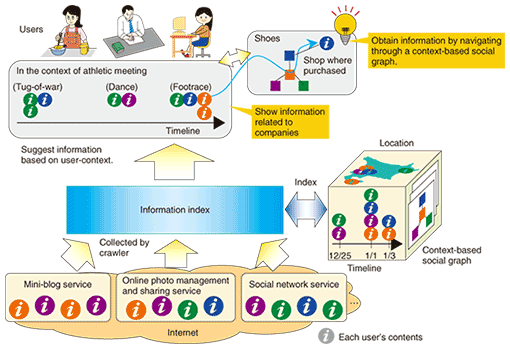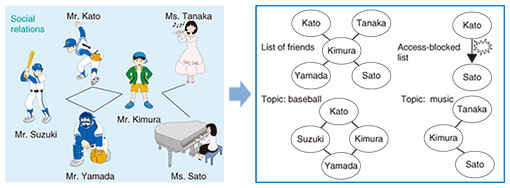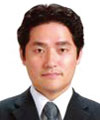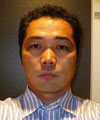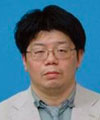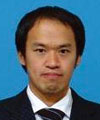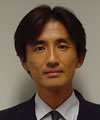 |
|||
|
|
|||
|
Special Feature: NGN Focus Vol. 7, No. 11, pp. 23–26, Nov. 2009. https://doi.org/10.53829/ntr200911sf5 Information Structuring Technology for Information Processing in the Ubiquitous SocietyAbstractThis article describes information structuring technology, which collects various types of user-originated information being distributed and stored on Internet services, indexes this massive amount of diverse information on the basis of individual behavior and history, and presents it according to a user’s conditions with the aim of revealing new facts and promoting insights.
1. IntroductionThe ever-expanding ubiquitous society has made it easier than ever for users to post photographs and comments on everyday life and events such as trips, athletics events, and shopping experiences on various kinds of Internet services without much conscious effort. Although some pieces of information may be interrelated, since such relationships are not stored anywhere, a user is forced to switch back and forth between services and rely on memory to find such associations. While conventional keyword-based search techniques present formulistic search results for specified keywords, to obtain pertinent results one must provide accurate search conditions. This is not necessarily easy; moreover, there are few means of finding items of value or interest among those search results. In response to these problems, we are researching and developing information structuring technology for collecting information, assigning relationships between different pieces of information, and presenting those relationships according to certain conditions. This technology consists of an information indexer, which organizes information based on time, place, and human relationships, and base technology for social graphs, which assigns relationships to information specific to human relationships. 2. Information structuring technology2.1 OutlineInformation structuring technology consists of three key processes: information collection, indexing, and presentation. The typical flow of actions is as follows (Fig. 1).
(1) Various users post information (e.g., photographs and comments) about events and other day-to-day matters on various services, which store it. (2) The posted information is collected by a Web crawler or other means. (3) The information is indexed from the viewpoints of time, place, people, etc. These viewpoints are set in accordance with items (times, places, human relationships, etc.) that users tend to prefer when browsing through information. (4) Information is extracted, sorted, and displayed according to conditions and viewpoints specified by the user. (5) A user examines the displayed information, focuses on information that appears desirable or important, and switches viewpoint to extract and sort new information. (6) The user examines the newly displayed information and repeats (5) to get closer to the target or interesting information. This process is defined as tracing. Information structuring technology lets users trace highly associative information that has associations between different pieces of information corresponding to certain conditions or to associations based on human relationships. It presents the user with highly reliable and relevant information while promoting the discovery of new information and the generation of insights. 2.2 Information indexerThe information indexer does not limit itself to feature attributes belonging to information that is expected to be targeted. It also uses relationships between pieces of information, such as information about a traveling companion extracted from the user’s personal history, so that information can be traced. This technology assigns relationships to information in a hierarchical manner based on subjective memory (e.g., information posted in schedulers and mini-blogs (web logs)) and objective facts (information such as visited locations and companions obtained by analyzing data from a GPS (global positioning system) device, RF-ID (radio-frequency identification) tags, and other types of sensors). Indexing information in this way makes it possible to trace connected information systematically using key conditions such as place, time, people, and names. When information is associated and traced in this way, the user can obtain information without the usual heavy reliance on memory. For example, consider the question: “What is the name of the Korean barbecue restaurant where Mr. Uesugi and I ate dinner during our trip to Yonezawa last month?” In this case, if a conventional search technique using the keywords “Yonezawa” and “Korean barbecue” were used, the user would have to search for relevant information from the huge number of search results returned, which would take a lot of effort. By contrast, the information indexer makes use of behavior-related facts included in the original question such as last month, Mr. Uesugi, trip, Yonezawa, and Korean barbecue. Thus, by tracing information indexed on the basis of such facts, the user can get the restaurant’s name more efficiently. 2.3 Base technology for social graphsAs depicted in Fig. 2, base technology for social graphs can dynamically display a person’s relationships with his or her friends in relation to various keywords (topics) in the form of a graph. This structure can also reveal the primary person (authority) for a certain topic on the periphery of the central character and the strength of that person’s human relationships.
For example, the strengths of Mr. Kimura’s relationships in Fig. 2 can be depicted as follows: Kato, Yamada > Tanaka > Suzuki, Sato For example, it turns out that Mr. Kato and Mr. Yamada have a common friend in Mr. Suzuki, which makes their friendship even stronger. Ms. Sato, meanwhile, has blocked Mr. Kato from accessing her, and since Mr. Suzuki is not a direct friend of Ms. Sato, their friendship is weak. Evaluating relationship strengths in this way and combining the results related to a certain topic lets one obtain the human relationships centered on Mr. Kimura in relation to various topics in the form of a graph (social graph). Such social graphs can be used to trace information from human relationships and obtain more reliable information. They can help a user discover an authority on a certain topic and obtain useful information posted by that authority. 3. Future outlookWe intend to continue our research with specific services in mind with the aim of establishing information structuring as a useful technology. By making efficient use of real information (weather and other environmental information, historical information about people and things, etc.) obtained from diverse services on the Next Generation Network, we expect to develop information structuring technology that can extract highly accurate situations related to our daily lives, making it applicable to new information searching services. |
|||








